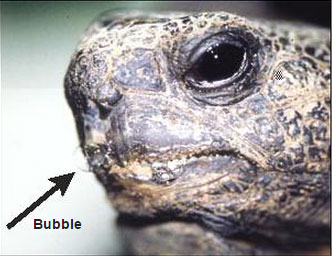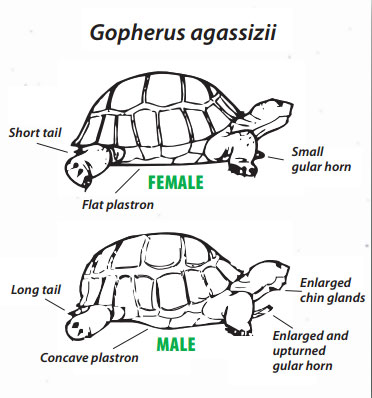Accident and Injuries
Upper Respiratory

Age
Unless the date of hatching is known, accurately determining the age of a wild or captive tortoise is not possible. The rate of growth depends upon the amount of body building food eaten.
Tortoises develop none to several growth rings on each plate of the shell per year depending upon the quality and quantity of food eaten. For this reason growth rings are not an accurate guide. Eventually, rings wear and weather. A tortoise with a smooth shell is “old” but “how old”?
Tortoises live about as long as human beings.
Male or Female?
Sexual maturity is a matter of size rather than age. For a female, this is usually at 7-8 inches. This is the shell length when measured down the middle of the shell front to back as a straight, not curved, line.
One way of telling the sexes apart is by the presence or absence of a concavity (depression) in the posterior third of the plastron (lower shell). The hatchling has a flat plastron, and for males it remains at until he is about 6 ½ to 7 inches long. Gradually, the male’s plastron becomes concave. The
plastron of females remains flat (or almost flat) throughout life.

Males have longer tails and a longer and usually upturned gular horn that projects from the front of the plastron. The horn is not developed in juveniles and by the time it can be used to separate the sexes, the presence or absence of the plastral concavity can be used.
Males usually attain a larger size than females but all tortoises seem to
grow, even in minute amounts, throughout life. As males mature they develop chin glands, one on either side near the front of the lower edge of
the lower jaw. The enlargement of these glands is seasonal. At some times of the year the glands of the males may be as small as those of females.
The nails on the hind feet of older females tend to appear unusually long. This is normal, and may be an adaptation, as nests are dug with the hind feet.
Recently, researchers determined that the sex of desert tortoises, like that of some other turtle species, is determined by incubation temperature. Incubation temperatures of 91 to 95.5ºF produced females, 78.8 to 87ºF produced males. At about 89.2 both sexes were produced.
